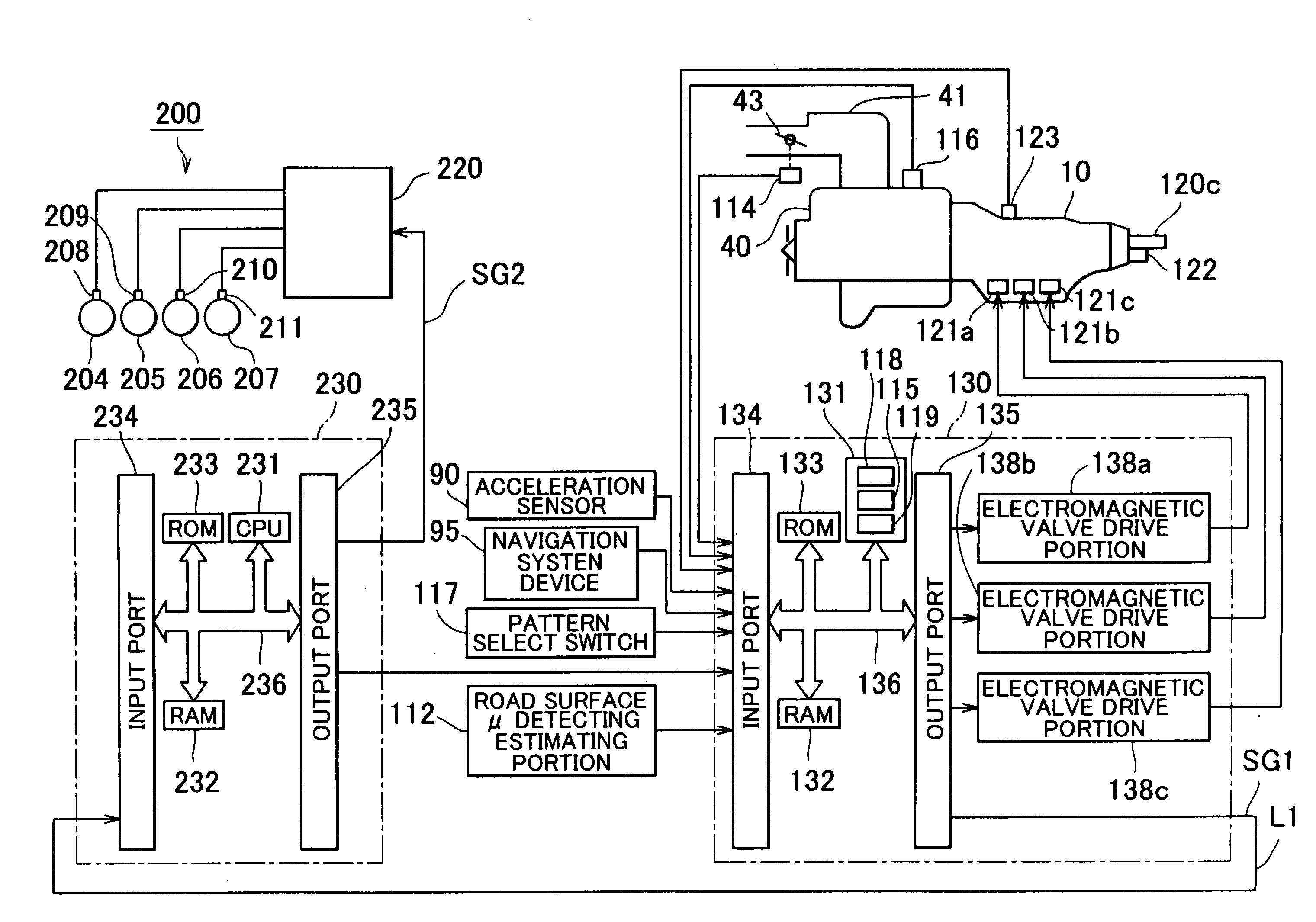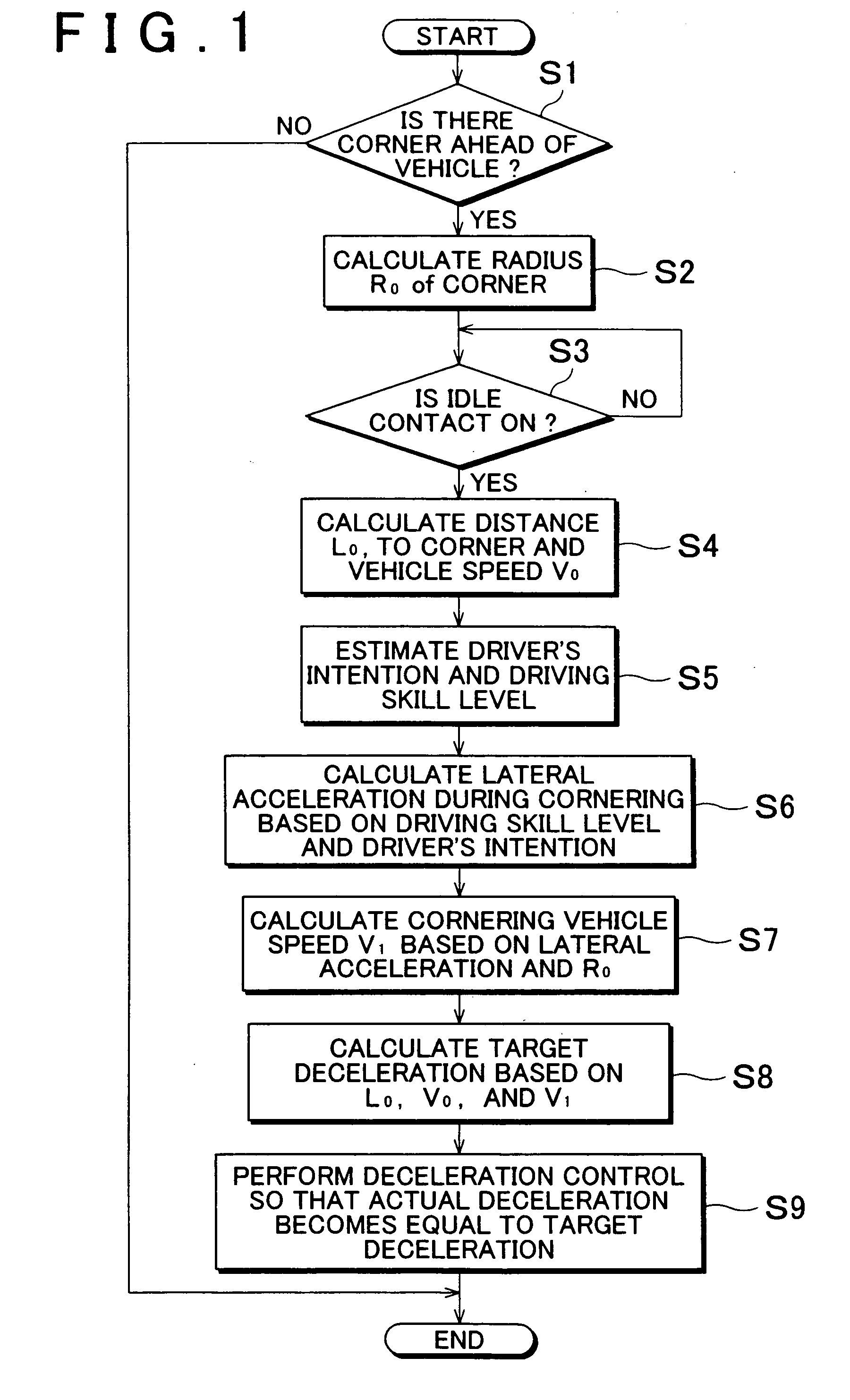Deceleration control apparatus and deceleration control method for vehicle
a control apparatus and vehicle technology, applied in the direction of brake systems, instruments, tractors, etc., can solve the problems of unnecessary control and unnecessary warnings
- Summary
- Abstract
- Description
- Claims
- Application Information
AI Technical Summary
Benefits of technology
Problems solved by technology
Method used
Image
Examples
first embodiment
[0039] A first embodiment will be described with reference to FIG. 1 to FIG. 11. The first embodiment relates to a deceleration control apparatus for a vehicle, which performs deceleration control using a brake (braking device).
[0040] In this embodiment, in deceleration control which decreases a vehicle speed to an appropriate cornering vehicle speed when a corner is detected ahead of a vehicle, and driver's intention to perform deceleration is detected, a target gravitational deceleration (hereinafter, referred to as “target deceleration”) is calculated based on driver's intention relating to running of the vehicle, a driving skill level, a vehicle speed when an accelerator pedal is released, a distance to the corner, and a radius of the corner. The deceleration control is performed so that actual deceleration becomes equal to the target deceleration. Thus, the deceleration control which allows the driver to feel comfortable is performed.
[0041] As described later in detail, a dec...
second embodiment
[0146] Next, a second embodiment will be described. The second embodiment relates to a deceleration control apparatus which performs cooperative control of the brake (brake device) and the automatic transmission. In the second embodiment, description of the same portions as in the first embodiment will be omitted, and only characteristic portions will be described.
[0147] In the second embodiment, the same operations as those in steps S1 to S8 in FIG. 1 in the first embodiment are performed. An operation in step S9 in the second embodiment is different from the operation in step S9 in the first embodiment. That is, in the first embodiment, the deceleration control is performed so that the deceleration applied to the vehicle becomes equal to the target deceleration obtained in the aforementioned step S8, using only the brake. Meanwhile, in the second embodiment, deceleration control is performed so that the deceleration applied to the vehicle becomes equal to the target deceleration ...
third embodiment
[0171] Next, a third embodiment will be described.
[0172] Description of the same portions as in the aforementioned embodiments will be omitted, and only the characteristic portion will be described.
[0173] In the third embodiment, the target deceleration calculated in the aforementioned step S8 in FIG. 1 is corrected by a road inclination in step S9, whereby deceleration at which the driver feels more comfortable can be obtained (i.e., deceleration expected by the driver can be obtained). That is, in the third embodiment, an operation in step S9 is different from the operation in step S9 in the first embodiment or the second embodiment (operations in steps S1 to S8 are the same as in the first embodiment or the second embodiment).
[0174] [Step S9]
[0175] In step S9 in the third embodiment, the road inclination measuring estimating portion 118 measures or estimates the road inclination. Next, an inclination correction amount (deceleration) corresponding to the road inclination measur...
PUM
 Login to View More
Login to View More Abstract
Description
Claims
Application Information
 Login to View More
Login to View More - R&D
- Intellectual Property
- Life Sciences
- Materials
- Tech Scout
- Unparalleled Data Quality
- Higher Quality Content
- 60% Fewer Hallucinations
Browse by: Latest US Patents, China's latest patents, Technical Efficacy Thesaurus, Application Domain, Technology Topic, Popular Technical Reports.
© 2025 PatSnap. All rights reserved.Legal|Privacy policy|Modern Slavery Act Transparency Statement|Sitemap|About US| Contact US: help@patsnap.com



